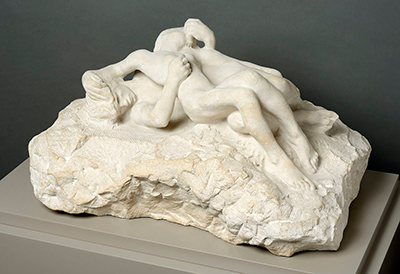Rodin did a sculptural group based on the characters from Dante Alighieri's Divine Comedy. Paolo and Francesca Rimini were lovers who were condemned to suffer in hell for their illicit affair. Francesca da Polenta was married to Giovanni Malatesta of Rimini who had a physical disability. However, Francesca fell in love with her husband's brother, Paolo and the two started an affair.
Giovanni killed them both when he caught them. In his epic poem, Divine Comedy, Alighieri wrote that he encountered Paolo and Francesca as he was touring around hell. The poem made the tragic love story of Francesca and Paolo famous and the inspiration of many artistic pieces. In Paolo and Francesca, or Couple Damné, the man is sprawled on his back while the woman lies on her back across his torso. The two seem to be lost in thought as they lay there. Francesca's outstretched right hand rests on Paolo's crown while the other hand is limp on his thighs. Almost no history exists on this painting, so it can be hard to tell the exact context for it.
The two lovers may be just laying in bed in one of their amorous encounters or it could be the moment Giovanni killed them. Legend is that the husband caught the pair in bed and murdered them right there, although there's no historical information to prove that narrative. Whatever the story, Rodin's carving shows how comfortable the two lovers are in each other's arms. This white stone carving is one in several pieces that Rodin did using the same subject for inspiration. The Kiss is the most famous Paolo and Francesca Rimini sculpture by Rodin. He also used the subject as part of his work for The Gates of Hell inspired by Dante's Inferno.
One thing that is common in Rodin's Paolo and Francesca sculptural group is the desire and anguish between the lovers. In this piece, the lovers are intertwined in a way that doesn't leave doubt about how they felt for each other. However, there's also a hint of worry on Paolo's face perhaps because he is wary of getting caught. Auguste Rodin had a penchant for bringing out the emotions of his subjects in his sculptures. This Paolo and Francesca stone carving closely resembles a similar piece by Rodin called Fugitive Love (1886). They both present raw feelings that contribute to the realism of the sculptures.




